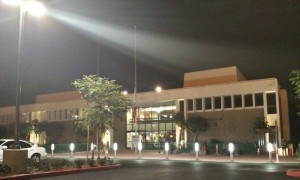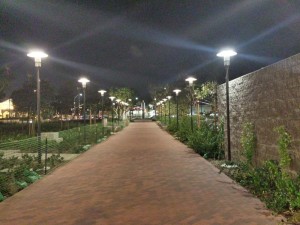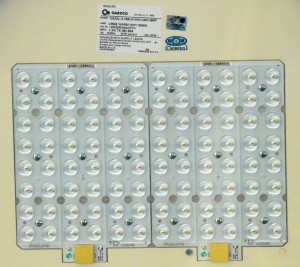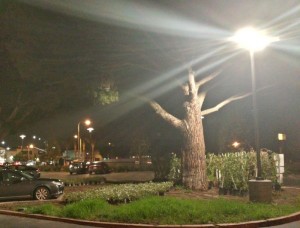 One thing I’m glad to see is that many of the problematic parking lot lights have been replaced. These are the ones with the big, pinkish yellow light in them that has what I call the ten off, ten on syndrome. Once the light has spent a half hour heating up, it stays lit for roughly 10 to 15 minutes, then goes off for about the same time until it cools and comes back on again. Someone wants to go to their car at night and it’s totally dark. They report the lamp as broken, and the maintenance guy goes out to check it. Well, he turns on the lights and this one works just fine for maybe 30 minutes until it gets hot, but by that time the guy has lost patience and wrote off the complaint as no problem found and leaves to fix something else.
One thing I’m glad to see is that many of the problematic parking lot lights have been replaced. These are the ones with the big, pinkish yellow light in them that has what I call the ten off, ten on syndrome. Once the light has spent a half hour heating up, it stays lit for roughly 10 to 15 minutes, then goes off for about the same time until it cools and comes back on again. Someone wants to go to their car at night and it’s totally dark. They report the lamp as broken, and the maintenance guy goes out to check it. Well, he turns on the lights and this one works just fine for maybe 30 minutes until it gets hot, but by that time the guy has lost patience and wrote off the complaint as no problem found and leaves to fix something else.
After the perimeter construction on campus was finished and the lighting was installed, I was leaving from work before dark and had not seen the new LED parking lot lights at night. Tonight I stayed until after dark and took a few pictures of the LED lights in the parking lot (they’re BRIGHT!) and the decorative lighting in the walkways, etc. You may have to click on them more than once to enlarge them to full size.
The last images are of the LED light itself. The pics were taken fifteen feet below with a telephoto lens so they aren’t all that clear, but that’s as close as I could get. There are eight rows of 12 LEDs per row, for 96 LEDs total. As the label says, they’re Cree. I find that odd, because Philips is (or was) a part owner of LumiLEDs and I thought they made their own LEDs. But then if you need 96 per light, that’s a whole lotta LEDs and you may need to obtain a lot of them from any source, including the competition. I looked up some light similar to this and saw they may cost anywhere from roughly $500 to $1600 (USD). Some of those were not LEDs, so I’m guessing that even though the cost of LEDs have come down, the LED lights are probably on the high end of those prices. At night they don’t look like warm white to me; they look like bright white. But they are so bright that you can’t look directly at them, just like the sun.
I find these LED lights to be one of the few improvements that were made by the remodeling construction. Not only was there 9 months of inconvenience with parking lots shut down, and construction dust and debris which is still ongoing, but the results afterward were worse in my opinion. Many ‘improvements’ turned out to be detrimental to the campus in my opinion.
One example is signs that are on the cinder block columns that are located at the exit to each parking lot. Before, the signs were on a slender metal post which you could see around when you were looking for cross traffic on the road. Now the sign on the cinder block column blocks the view of the road, and you have to pull out further into the road to see around them, making the exit more unsafe.

But I think the absolutely stupidest thing they ever did was to reduce and remove the cinder block wall around the perimeter of the campus. Originally the wall was about four feet tall, so most people would have to walk around it to get to the bus stop or cross the street. Now in some places such as the bus stop the fence is about knee high and not difficult to step over for most people. But when the bus gets ready to leave, you see these late people running to catch it. Someone in a hurry is going to try to jump over the wall and fall and seriously injure themselves and our college will get blamed for making the wall unsafe. In effect, it’s just more of an obstruction than it is a fence or barrier.
 And then in some places they removed the wall and replaced it with shrubs which look like hedge plants. This is going to get out of hand because it’s a lot more work than a wall to keep it watered, trimmed and maintained. And this low wall or no wall will allow the middle school students walking down the street easier access to passing through our campus. with more negative results. A few of these immature kids have become a graffiti and vandalism problem but now it’s going to get worse. We install security cameras all over our campus, but really, what good does that do? Once the tagger or vandal is on the campus and does his damage, the security camera may take a clear picture of him and even get a license plate on a vehicle, which will probably get reported to the police. It’s doubtful that anyone will get caught and punished. And you still have the graffiti that has to be cleaned up or covered up. It’s a losing situation – it’s better to keep them out of the campus to begin with.
And then in some places they removed the wall and replaced it with shrubs which look like hedge plants. This is going to get out of hand because it’s a lot more work than a wall to keep it watered, trimmed and maintained. And this low wall or no wall will allow the middle school students walking down the street easier access to passing through our campus. with more negative results. A few of these immature kids have become a graffiti and vandalism problem but now it’s going to get worse. We install security cameras all over our campus, but really, what good does that do? Once the tagger or vandal is on the campus and does his damage, the security camera may take a clear picture of him and even get a license plate on a vehicle, which will probably get reported to the police. It’s doubtful that anyone will get caught and punished. And you still have the graffiti that has to be cleaned up or covered up. It’s a losing situation – it’s better to keep them out of the campus to begin with.
 I will say that the LED lights are a huge lighting improvement, and will save money on electricity too. But I drive around town and see the stop signals with red and green LEDs that have one or more rows of dead LEDs. Or they flicker on and off like some kind of alien space ship. They were fine for a few years after they were installed. Then I guess the city decided that the maintenance had dropped so they could lay off most of the maintenance guys. Now, a few years later, there are no longer enough maintenance guys to keep up with the LED light problems. Will these LED parking lights suffer a similar fate? These are up on a pole fifteen or more feet above the ground, so you can’t change one by standing on a chair, like a ceiling light.
I will say that the LED lights are a huge lighting improvement, and will save money on electricity too. But I drive around town and see the stop signals with red and green LEDs that have one or more rows of dead LEDs. Or they flicker on and off like some kind of alien space ship. They were fine for a few years after they were installed. Then I guess the city decided that the maintenance had dropped so they could lay off most of the maintenance guys. Now, a few years later, there are no longer enough maintenance guys to keep up with the LED light problems. Will these LED parking lights suffer a similar fate? These are up on a pole fifteen or more feet above the ground, so you can’t change one by standing on a chair, like a ceiling light.
For those astronomers out there, these lights will help cut down light pollution. The LEDs are pointing down so that none of the light shines up where it gets wasted and ends up just causing a grey haze across the city at night. However the flat top makes an excellent pigeon’s roost – or any other bird, for that matter. It will probably end up getting a ‘porcupine quill’ or ‘spike strip’ plate on the top to (hopefully) make the birds go away. I saw some eaves with those strips and the flying rats (pigeons) just landed on them and dealt with them as best as they could. I think chicken wire would have done a better job.
The electricians told me that the supply voltage to the parking lights is 277 volts, and the label says this LED light uses 0.58 amps at that voltage. That comes to 160.66 watts. I don’t know anything regarding how these LED lights are ballasted, but I assume that they use a SMPS (Switch Mode Power Supply). This is much like the power supply in a computer, and wastes very little power during operation – I’m guesstimating less than ten percent. If these are 1 watt LEDs, then the total power input should be 96 watts plus 9.6 watts in the PS, totaling 105.6 watts. Perhaps the 160 watts is the maximum value, and the light typically uses somewhere around 106 watts.
It looks like there are two arrays of 48 LEDs each. I would have to guess as to how the LEDs are connected. Possibly all in series. That would add up to 3.2V times 48 LEDs or 153.6V. Two panels in series add up to 307.2 volts. 277 volts AC rectified and filtered becomes 385V DC, which would be enough to power two panels in series. Then if the PS was a SMPS, it would be just as easy to have it put out 153.6 or whatever volts, and have that voltage current limited.
